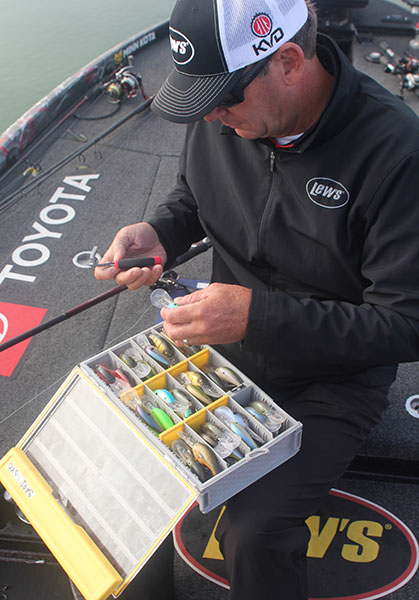By Kevin VanDam (As told to Louie Stout)
 Kevin VanDam
Kevin VanDam
In yesterday’s story, I offered the reasons I believe that water temperature is overrated when predicting activity levels in bass.
For years we’ve believed that, to catch bass in super cold water, you have to fish dainty baits vertically and ever-so-slowly.
My experiments while fishing through ice-covered lakes have proven that bass are more aggressive than some anglers believe and will bite faster moving baits.
Alabama Rig anglers confirmed that pulling multiple swimbaits horizontally during the coldest weather of the year produces big bass, and oftentimes, multiple fish on one rig.
My additional experiments, immediately before our northern lakes freeze and after they thaw, have proven that bass will hit power fishing type lures. Some of my favorites are crankbaits, jerkbaits, swim baits, swim jigs – all of which have provided me with remarkable success in very cold water while other anglers are trying to finesse the bites.
That doesn’t mean you can go down your favorite summertime bank and catch fish with summertime tactics. You still have to fish where the fish are when the water is cold.
Because the fish are tightly concentrated in super cold water, you have to cover a lot of water to find them. But when you do, there may be 100 bass in that little spot or stretch.
Electronics can clue you in. On reservoirs, the bass will follow the pods of shad that are 10 or 15 feet off the bottom. On our northern natural lakes, the bass are generally on or near the bottom and relating to the outside of weed lines. Once you find those elements, you’re in the right area.
The next step is to choose a lure that you can fish efficiently in that depth zone. On shallower waters, jerkbaits and mid-range crankbaits work well, and if fishing deeper I prefer swim baits and swim jigs.
Another key to remember is you can manage lure depth control and keep a bait in the correct zone by adjusting line sizes.
So, when I find fish in 15- to 25-foot depths, I will downsize my fluorocarbon line and upsize my jig weight to get those swimbaits and swim jigs deeper. The lighter line has less drag and the heavier jig head will help me keep the bait near bottom.
When fishing a swim jig in cold water, I will use a thin the jig skirt so it has less drag. Instead of using the traditional 40-strand skirt, I will take out 25 or so strands to reduce drag and keep the bait closer to the bottom.
One of the hardest things to do when fishing this during the early season is learning the “feel” that the bait is near the bottom or in the depth zone you’re fishing. It’s accomplished by paring a combination of line size, lure weight and retrieve speed to get the lure where the fish are holding.
I move these baits with a steady reeling action, but I don’t want to imply that I’m burning them through the water like I might do in warm-water periods. However, you’d be surprised at the pace you can fish these baits effectively.
I will fish slower, vertical baits in cold water, but that doesn’t become an option until I find those tightly grouped fish with faster moving baits and the bite has fallen off. That’s when I might pick up a jig or tube bait and make pinpoint casts to the area they are holding.
So keep that in mind the next time you’re fishing winter water aimlessly with a slow finesse tactic. Be open-minded; pick up a fast mover, cover water until you find the fish, and your catch rate will rise.


